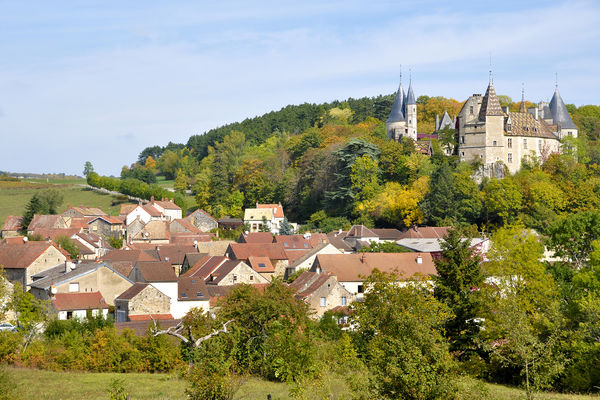Bikes and Wine: A Fine Blend in Burgundy
A leisurely bike ride between the Côte d'Or's picturesque villages may well be the most idyllic way to experience the immaculate vineyards of Burgundy's best wineries.
By Rick Steves

Biking and wine tasting may not seem like natural partners. But if you enjoy both, mixing the two can be a highlight of your next French journey. One of the best places to swirl, sip, and cycle is Burgundy, which is famous for peaceful lanes that lace together cute towns and venerable vineyards.
Start in Beaune, Burgundy's thriving and popular wine capital, which lies about 200 miles southeast of Paris. Much of Beaune's medieval wealth came from hardworking monks, who produced excellent wine and cheese while nearby dukes amassed power. The monks determined that pinot noir and chardonnay grapes grew best in Burgundy's particular climate and soil — a lesson that is followed to the letter by winemakers today.
It seems as if every other shop here sells wine, and some offer informal and informative tastings. You can taste directly at the domaine (winery) or at a caveau representing several wineries.
In Burgundy you can experience just about every aspect of wine production, right down to traditional barrel making. This time-honored craft is kept alive at cooperages, where barrels are crafted with a mix of modern efficiency and traditional techniques. Workmen use steam and bands of iron to bend oak staves into wine-tight casks. The characteristics of the wood contribute to the personality of Burgundy's wine.
In Beaune's town center, stop by the chamber of commerce to test your senses. A delightful exhibit there, the Cave aux Arômes, has glass cases — filled with fruits, nuts, herbs, and spices — that are designed to give visitors a chance to appreciate the complex aromas that sculpt fine wines. A good "nose" is a life skill worth developing.
From here, you're just minutes by rental bike from the vineyards. (Before you leave Beaune, consider following the foundations of the town's medieval walls on the ring road's bike path.)
Some of France's most reputed wineries span the peaceful 18-mile vineyard route south of Beaune, where you'll find the rolling hills of the Côte d'Or ("Gold Coast"). Drivers may have more flexibility to access each winery, but biking through waves of immaculate vineyards and picturesque villages is more idyllic.
Just a few miles south of Beaune, the villages of Pommard and Meursault offer clusters of respectable vineyards beyond their namesake châteaux. Here, I like to sample some of the world's best whites at the convivial Caveau de Puligny-Montrachet and explore striking 11th-century, barrel-lined cellars at the elegant Château de Chassagne-Montrachet.
With about 4,200 wineries in 44 villages, Burgundy's road maps read like fine-wine lists. Each bit of land in the region has its own terroir — a unique combination of macro- and microclimate, geology, soil characteristics, exposure to the sun, and altitude. Visitors are sometimes surprised by the poor-looking soil. Struggling to survive in the rocky ground, the grapevines manage to produce fruit of wonderful character and aromatic complexity.
Aficionados say that the quality of wine can be different from one spot to another just 200 yards away. As location is everything, winery names take a back seat to the place where the grape is grown.
You can easily cycle from domaine to domaine, sampling wines as you go. Look for smaller, lesser-known wineries, which tend to have the most passionate and personable vendors. Signs make it clear where visitors are welcome to stop in, enjoy a little tasting, and pick up a bottle or two. Although you can drop in unannounced at most wineries ("comme un cheveu sur la soupe" — "like a hair on the soup"), you'll get better service by calling ahead and letting them know you're coming.
At a typical tasting, the vintner pours a small amount of wine into a glass. (My Burgundian mentors remind me that tasting and drinking are two very different things: You drink wine with food, but you taste the wine "naked.") Before tasting, aficionados like to raise their glass to the light to admire the wine's rich color. Stick your nose right into the glass to get a sense of its bouquet, then aerate by swirling to release the undertones. Sniff again, and see if you notice the contrast. Then take a sip — and "chew" the wine to enjoy every note. Finally, spit it out into a receptacle, because, as one vintner told me, "the stomach does not taste."
If you're envisioning a progressively more wobbly pedal, remember that the most serious wine tasters make a point to use the spittoon so they can taste all day without their judgment becoming clouded. You can do the same to ensure you stay safely on the road.
After a pleasant pedal back to Beaune, you're all set to relax and enjoy a serene evening. Stroll the delicately lit streets lassoed within the town's medieval walls and reflect on the day's drinkable delights. In the heart of France, the wine is good, the landscapes are luscious, and life is leisurely.

